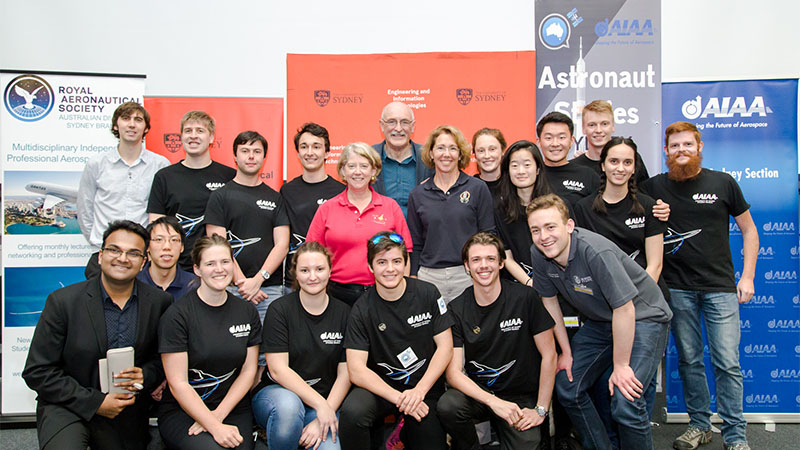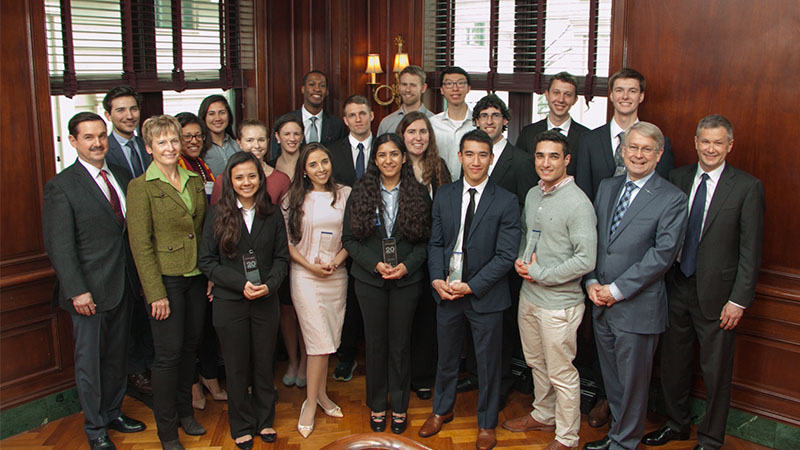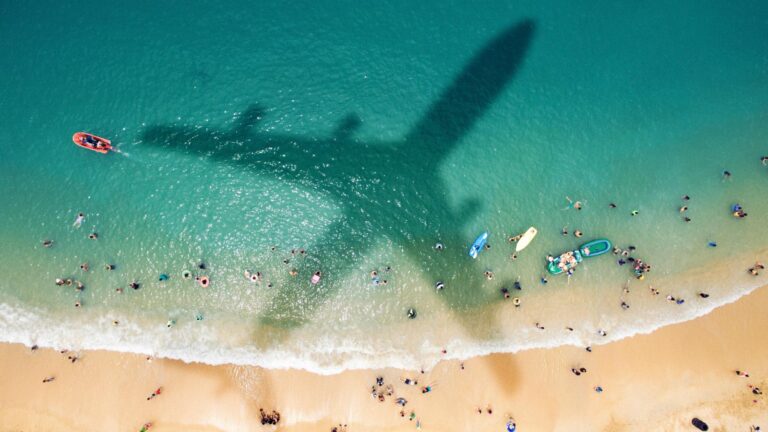Stay Up to Date
Submit your email address to receive the latest industry and Aerospace America news.

Astronaut Stories Australia Fosters Interest in the Aerospace Industry
Contributors: Abhijeet Kumar, Benjamin Morrell, Liam Heidt, Bhavraj Thethy, Brock Little
In fall 2017 the AIAA Sydney Section organized Astronaut Stories Australia, a series of public outreach events designed to connect students, researchers, and the public with leading icons of the space industry to increase public interest in space-based activities and the wonder of space, as well as motivating support of scientific and technical exploration. The events took advantage of the large number of astronauts who came to Australia for the International Astronautical Congress (held in Adelaide in late September).
Events were planned in Canberra, Sydney, Melbourne, and Brisbane, and each event included an astronaut to headline a STEM workshop for high school students and a large public presentation. The student event (From STEM to Space) was designed to spark an interest in STEM careers. The events included a presentation and Q&A with a panel of astronauts and local STEM role models, followed by hands-on science and engineering activities. The public event (An Evening of Astronaut Stories) aimed to foster a passion and interest for space activities. An astronaut shared stories from their career and from when they were in space, followed by an audience Q&A session.
The events had a tremendous turnout: over 1,000 students participated in the STEM events and 5,000 individuals, including a large number of children, participated in the evening events.
Canberra Event
The first event was held on 19 September at the University of New South Wales Canberra. Col. Pamela Melroy spoke to 70 students from eight schools about the technical engineering challenges that she faced in space and the simple ingenuity that is required of astronauts to come up with simple fixes to challenging problems. She was joined by five other aerospace professionals who answered insightful questions from the students about physics in space, what the hypersonic regime entails what career pathways lead to a career in space, and the role of artificial intelligence in space. This was followed by a rocket activity where students had to design the fin and nosecone of their air-powered rocket with design considerations and constraints based on maneuverability and stability. They were introduced to rocket physics and what would help the rocket reach the highest altitude possible. The next activity entailed spaceship design with Dr. Sean Tuttle (ESA Rosetta engineer), which focused on systems integration, followed by a session on trajectory design with Dr. Doug Griffin and Prof. Andrew Neely, which focused on launch, travel, and reentry of spacecraft heading to Mars.
The evening event, hosted by SQNLDR Marija Jovanovich, included a presentation by Col. Melroy followed by a Q&A where many children had the chance to ask questions. Numerous audience members expressed profound wonder and excitement at the end of the event where human spaceflight, advocacy and policy, career pathways, and space exploration were discussed. The event was livetweeted, which meant there was good engagement throughout the Canberra community.
Sydney Event
The Sydney STEM event took place on 21 September with Col. Melroy, Dr. Sandy Magnus, Dr. Sydney Do, and Mr. Warwick Holmes participating, and included 180 students from eight schools. The panelists spoke about their career journey and STEM education, trying to inspire students from a lower socioeconomic background to explore science and technology. The students participated in activities involving programming Arduinos, virtual reality, a Mars Yard, and a spacewalk. Feedback from the program suggested that the students were inspired to select a high math level or science unit for their school courses after the program and saw a life for themselves in the STEM disciplines.
Five hundred people attended the evening event where Col. Melroy and Dr. Magnus were hosted by Dr. Fred Watson. After an introductory presentation, there was a Q&A session where questions ranged from the technical to the aspirational.
Melbourne Event
On 20 September, “From STEM to Space Melbourne” took place at ScienceWorks, Museums Victoria. One hundred students from 10 schools from low socioeconomic areas attended the entire program. A further 600 students from 14 schools around Victoria attended a portion of the program via video conference. The program was split into a rocket workshop run by the Australian Youth Aerospace Association (AYAA), where the students learned to conduct the hands-on design and manufacture of chemical rockets, and a talk by either Tony Antonelli or Dorin Prunariu about their experience as astronauts. The students were allowed to explore the ScienceWorks museum during the lunch break to see the range of exhibits on display. Noting the problem of gender balance and equal representation in engineering today, a broader goal of the Melbourne event was to attempt to achieve a balance in gender, and about 65% of the students were female. The volunteers were an equal 50-50 representation of male and female. By targeting females at a young age, the sections hopes to encourage more of them into STEM roles.
A VIP Night was held on 20 September with members of Museums Victoria and representatives from the aerospace industry, including Boeing, DST Group, BAE Systems, Nova Systems, RAeS, Monash University, RMIT, and the University of Melbourne. An Evening of Astronaut Stories Melbourne (with Tony Antonelli) was held on 23 September in conjunction with the AstroLight Festival. About 1,600 attendees were at the festival, and the Amphitheatre was completely full with the talk being livestreamed to other areas of the festival. The children in the audience were encouraged to ask questions and Antonelli emphasized the importance of math and science in school and made a big impression on the children. The final event of the evening was a panel event focused on “Space Science in 2030” with Dr. Sarah Wittig (European Space Agency), Dr. Gail Iles (formerly ESA and now RMIT) and Dr. Katie Mack (University of Melbourne). Incoming AIAA Melbourne Section Chair Dr. Daniel Edginton-Mitchell moderated the panel. Topics ranged from black holes and space travel to the importance of women in STEM. AIAA also ran an information booth at the AstroLight festival and were happy to have more than 80 individuals interested in future events.
Brisbane Event
On 3 October, “From STEM to Space Brisbane” took place at the University of Queensland (UQ) St. Lucia campus. Seventy-three students from five schools attended the program, which included a talk from panelists, including astronaut Christer Fuglesang, on how the panelists had transitioned from secondary school to a STEM career. There was a strong career focus, with discussions on the practical steps to pursue a STEM career and the skills required to do so. The students also had the opportunity to design, build, and launch rockets, with the help of Kate Dent from AYAA. This project was similar to the one at Canberra and Melbourne and students needed to design and integrate fins, nosecone, and a parachute, so that their rocket would reach the highest altitude possible. Fuglesang watched the rocket launches, asking questions about the designs and talked with the students about how the performance compared with their predictions. The students also had a chance to tour the university’s Civil Engineering Labs, Additive Manufacturing Labs, Super-orbital Expansion Tube Laboratory, and UQ Racing Workshop.
That evening at Astronaut Stories Brisbane approximately 270 attendees listened to a short address about the STEM careers available at UQ before Fuglesang spoke to the audience about his experiences and then answered questions with TV science presenter Lee Constable.
Volunteer Committee
To organize these events, students working with the AIAA Sydney Section formed a national committee that worked with teams in each city. The 20 committee members also had a large team of about 60 other volunteers across the four cities. The events benefited from partnerships with different organizations: Scienceworks in Melbourne provided the venue for the events, and combined the events with their Astrolight Festival; the Museum of Applied Arts and Sciences in Sydney hosed the STEM event and coordinated the STEM workshop; Sydney Ideas helped host the Sydney evening events; and the Australian Youth Aerospace Association ran the events in Brisbane and the STEM activities in Melbourne.
Event sponsors were the Royal Aeronautical Society (national partner) and local sponsors were the University of Queensland, University of Sydney, University of NSW Canberra, and Monash University.

Tomorrow’s Engineering Leaders: The 20 Twenties
Thirteen AIAA student members have been named winners of Aviation Week Network’s award program: Tomorrow’s Engineering Leaders: The 20 Twenties.
The award recognizes students who are nominated by their universities on the basis of their academic performance, civic contribution, and research or design project. The winners were honored during Aviation Week’s 61st Annual Laureate Awards on 1 March at the National Building Museum in Washington, DC. At the event, AIAA President-Elect John Langford, CEO and President of Aurora Flight Sciences, a Boeing Company, was honored with a Lifetime Achievement Award, and AIAA corporate members SpaceX and Boeing were named as Grand Laureate of the Space and Defense divisions, respectively.
(More details can be found at: aiaa.org/2018-Laureate-Awards-and-20-Twenties-Winners)
Call for Papers Now Open for the 29th Space Flight Mechanics Meeting
The 29th Space Flight Mechanics Meeting will be held 13–17 January 2019 at the Sheraton Maui Resort & Spa in Ka’anapali, HI. The conference is organized by the American Astronautical Society (AAS) Space Flight Mechanics Committee and cosponsored by the AIAA Astrodynamics Technical Committee. Manuscripts will be accepted based on their quality of the extended abstract, the originality of the work and/or ideas, and the anticipated interest in the proposed subject. The abstract deadline is 14 September 2018. Complete manuscripts are required before the conference. Full details can be found at the website: http://space-flight.org/docs/2019_winter/2019_winter.html.
Working Across Different Disciplines—Society and Aerospace Technology Integration and Outreach Committee
By: Dr. Amir S. Gohardani, SAT IOC, Chair
Following the latest face-to-face meeting of the Society and Aerospace Technology Integration and Outreach Committee (SAT IOC) at the 2018 AIAA SciTech Forum in January, SAT IOC is following up its objectives to identify impacts of technology on society. A sequential approach for the committee is to mirror the findings from potential studies into these topics. SAT IOC is actively pursuing a variety of different activities and will have several sessions at the 2018 AIAA SPACE Forum in September (for more information, go to space.aiaa.org/getalerts).
Most recently, additional updates have also been made to the SAT IOC webpage as the committee explores collaborative efforts with other AIAA IOCs and technical committees. A red thread that runs through most SAT IOC activities is the multidisciplinary topics that enable a more all-inclusive vantage point about the aerospace technologies impacting society. SAT IOC is committed to facilitate knowledge transfer between different subject areas and share those findings with the general public.

AIAA/ACC/AAAE Speas Award Presented in March
On 1 March, the 2018 AIAA/AAAE/ACC Jay Hollingsworth Speas Airport Award was presented to the Gerald R. Ford International Airport Authority during an awards luncheon at the 2018 AAAE/ACC Airport Planning, Design and Construction Symposium. The airport authority was recognized for an innovative and sustainable stormwater and deicing treatment system that provides an example to other airports in meeting operational, regulatory and community needs. Roy Hawkins, planning engineer, accepted the award.
The Speas award was established in 1983 and is presented annually to the nominee(s) judged to have contributed most significantly in recent years to the enhancement of relationships between airports and/or heliports and their surrounding environments via exemplary innovation that might be replicated elsewhere.
AIAA Journals Announcement
To leverage advances in publishing technology, AIAA has been transitioning our technical journals away from the traditional print format over the past few years. This process will be complete in January 2019. Journal of Aircraft (JA), Journal of Guidance, Control, and Dynamics (JGCD), Journal of Spacecraft and Rockets (JSR), Journal of Propulsion and Power (JPP), and Journal of Thermodynamics and Heat Transfer (JTHT) will be the last of the journals to move to an online-only format in 2019. The final 2018 issue for each of these journals will be the last issue distributed in print.
Print customers transitioning to the online format will be able to maximize the user experience with research tools and access to the most up-to-date versions of articles in Aerospace Research Central. All of AIAA’s technical journals will continue to publish high-quality, original research papers spanning the spectrum of aerospace science and technology and reporting on the most critical aerospace advances.
AIAA Associate Fellow D’Urso Died in February
Steven J. D’Urso died on 16 February. He was 65 years old.
Mr. D’Urso graduated from the University of Illinois at Urbana-Champaign (UIUC) with a B.S. in Mechanical Engineering (1978). He also earned an M.S. degree in Aeronautical and Astronautical Engineering (1989) through the special off-campus graduate program that the UIUC Aerospace Engineering (AE) department delivered to McDonnell-Douglas in the 1980s.
After graduation he accepted a position with Boeing Seattle as a design engineer specializing in structural and mechanical design. During his three years in Seattle he contributed to the design of the Boeing 767 aircraft. In 1980 he joined the McDonnell Aircraft Company as a Technical Specialist for configuration design before being promoted to Senior Principal Engineer and then to a Senior Systems Manager. It was during this time period that he made significant contributions to the Joint Strike Fighter competition. In particular, he produced a fuselage re-design of the X-32 that eliminated the “ugly moniker” associated with that aircraft.
During his time at McDonnell Aircraft, Steve demonstrated his natural teaching abilities early by developing and teaching three aircraft design related courses that were taught as part of the McDonnell Voluntary Improvement Program (Aircraft Configuration Design, Unigraphics I and II 3-D Design, Design for Manufacturability). Additionally, while at McDonnell-Douglas Mr. D’Urso made biweekly visits to the UIUC campus to assist Professor Ken Sivier with the teaching of the AE senior design courses. He also served on the AE Academic Advisory Board from 1991 to 2011 and was its VP (1995–1996) as well as president (1997–2000). Additionally, he served on the UIUC College of Engineering Advisory Board (1997–2000).
After his retirement in 2011 as Senior Systems Engineer/Manager at The Boeing Company, Mr. D’Urso returned to UIUC as a Lecturer and Program Coordinator for Aerospace Systems Engineering in the Aerospace Engineering Department. He organized and initiated the latter undergraduate and graduate programs. He also taught the two-semester senior aeronautical design capstone courses as well as a course systems engineering. His courses were convincing mixture of theory and rich contributions based on his many years of industrial experiences. Additionally, he advised undergraduates and graduates in special research courses and also supervised graduate thesis students.
Mr. D’Urso was an active member of the International Committee on System Engineering (INCOSE). As an AIAA Associate Fellow, he was actively engaged in research and a frequent paper contributor at AIAA conferences. He co-authored a book chapter and a number of significant research papers. Mr. D’Urso also was an active member on and contributor to the AIAA System Engineering Technical Committee.
Among his achievement awards are the McDonnell-Douglas Teammate of Distinction (1991) and Leadership Award (1992); the UIUC AE Department Outstanding Recent Alumnus Award (1994) and Distinguished Alumnus Award (1998); and the Boeing Integrated Defense Systems Performance Awards (2000, 2003) and Leadership Award (2007).
AIAA Associate Fellow Barnard Died in February
Harry R. Barnard, age 82, died on 25 February.
Barnard attended Texas A&M University, earning his degree in Aerospace Engineering (1962). He earned his masters degree in Aerospace Engineering from Southern Methodist University (1969).
In the 1960s, he worked at General Dynamics, Bell Helicopter, and LTV Aerospace Corporation before moving to Texas Instruments where he was an aerodynamic project engineer for the 155 mm Cannon Launched Guided Projectile Program among other projects. In 1983, he moved to Lockheed Martin Missiles and Fire Control as a Lockheed Martin Fellow. He was experienced in the design, analysis, and testing of guided missiles, gun fired guided projectiles and pilotless aircraft. His tasks included aerodynamic coefficient determination, aerodynamic and inertial loads determination, flight dynamics, wind tunnel testing, autopilot and control system analysis, six-DOF simulation, rocket, turbojet, pulsejet and ramjet performance analysis, aero-elastic analysis and aerodynamic heating analysis. He taught Lockheed Martin in-house courses related to missile/aircraft propulsion, missile/aircraft conceptual design and aerodynamics.
Mr. Barnard was also an adjunct professor at the University of Texas at Arlington. He was a member of the AIAA Gas Turbine Engines Technical Committee and supported both local and national AIAA activities.
Stay Up to Date
Submit your email address to receive the latest industry and Aerospace America news.




